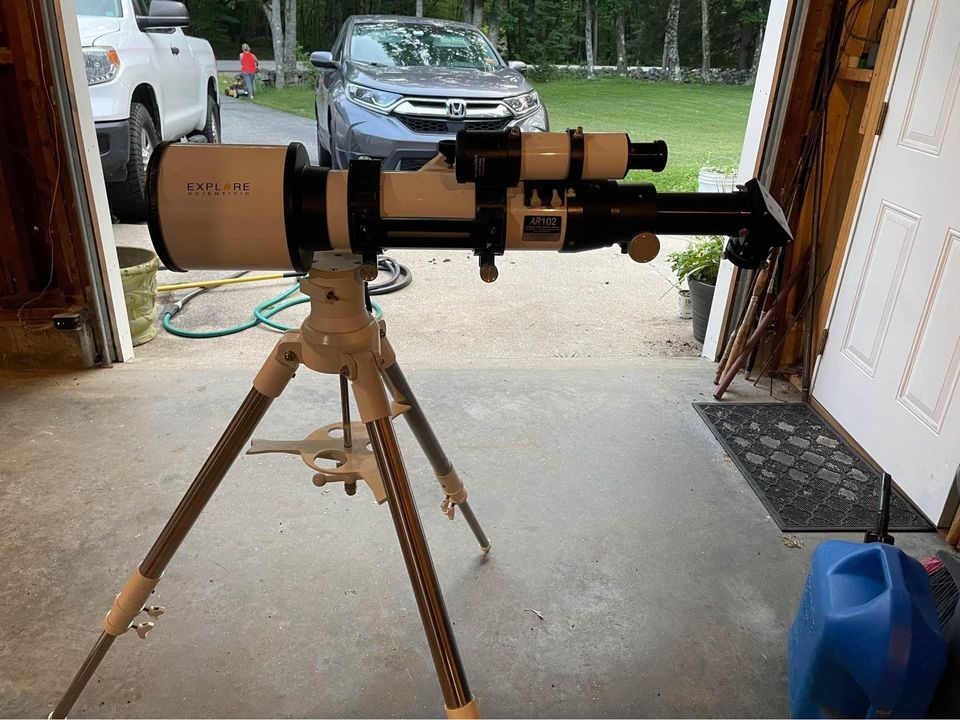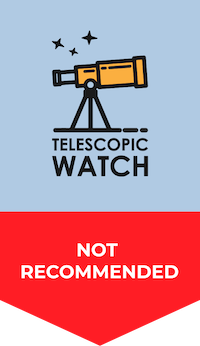
Optics
The AR102 is a 4” (102mm) f/6.5 achromatic doublet refractor with a focal length of 660mm. Being a standard Fraunhofer configuration achromatic doublet refractor with no special extra-low dispersion glass or anything of the sort—just standard crown and flint glass—it will obviously have some chromatic aberration as a result. It’s basic physics, and you can’t avoid it.
While it is still, of course, distracting, the chromatic aberration of the AR102 is remarkably well-controlled, only really being a problem on the Moon, Jupiter, and, of course, Venus. With a specialized “minus-violet,” “contrast booster,” or “fringe killer” filter, the purple haloes around these objects will disappear entirely, at the expense of natural-colored views. A cheap yellow filter will also work pretty well in a pinch.
Mechanics
The AR102’s lens cell is collimatable, should that ever be a necessity. The objective itself is fully multi-coated – which is to be expected with any decent refractor nowadays.
One of my main criticisms of the scope’s design is that I don’t particularly like the huge width and short length of the dew shield. By being super fat, it is less portable, the dew shield itself is less effective, and the short length further hampers its usefulness.
The AR102’s focuser is a nice, high-quality dual-speed Crayford – by itself easily worth ⅓ of the price of the entire telescope, and certainly, overkill for a scope that’s meant primarily for low-power wide-field views. It works very well. You could swap it out for a Moonlite or Feathertouch, but one of those units plus the necessary adapters would be approaching if not exceeding the price of the AR102 itself.
The AR102’s tube cradle is well-made, lined with felt inside the rings, and it comes with a nice carry handle on the top, as well as a standard aluminum Vixen dovetail on the bottom for attaching the telescope to most modern alt-azimuth and equatorial mounts.
Accessories
The finderscope supplied with the AR102 is a rather inexpensive 8×50, with an upside-down image and a somewhat narrow field of view. It’s not my favorite, but it’s more than sufficient. Swapping it out for a different one is a bit of a pain, as only Meade and Explore Scientific finders will fit the AR102’s non-standard finder shoe. Explore Scientific sells a very nice 50mm right-angle correct-image finderscope, which although expensive is probably what I’d recommend if you still want a finderscope and not a red dot unit or reflex sight.
The AR102 also comes with a 99% reflective, dielectric mirror diagonal with a compression ring adapter and a carbon-fiber body. This is a very nice diagonal that is identical to the one supplied with Explore Scientific’s far more expensive telescopes, and there are only a handful of uber premium diagonals on the market that are objectively better, none of which I really consider worth the money.
Sometimes, particularly around the holidays, Explore Scientific throws in a 25mm, 70-degree wide-field eyepiece for free, bundled with the AR102. Providing 26x and a true field of 2.7 degrees, it’s more or less perfect for a low-power, rich-field telescope. However, while the 25mm 70-degree eyepiece is a pretty good eyepiece, it doesn’t perform quite as well at the edge of the field of view as Explore Scientific’s more expensive 68-degree and 82-degree oculars.
Like all Explore Scientific products, the AR102 and its accessories come with the ExploreSTAR lifetime transferable warranty.
Mount Recommendations
The AR102 is available bundled with Explore Scientific’s Twilight I mount, which is an ideal manual alt-azimuth mount for the job, if a little on the light-duty side. If you’re interested in equatorial tracking for visual-only use and don’t want the complications or expense of GoTo, the Celestron CG-4 or Orion SkyView Pro will work fabulously. You can also buy a GoTo equatorial mount such as the Celestron Advanced VX, Explore Scientific’s own EXOS-2, the Meade LX85, or the Orion SkyView Pro or Sirius.
Should I buy a Used Explore Scientific AR102?
Refractors are the most reliable and durable telescopes out there, so there’s not much that can go wrong with a used AR102 that won’t be immediately obvious, such as damage to the objective lens or focuser. If the scope is not sold with a valid, transferable lifetime warranty, it will usually command a lower price.
Aftermarket Accessory Recommendations
If you’re planning on doing any observing with the AR102, don’t forget to get eyepieces! Most wide-angle eyepiece designs are sharp at f/6.5. However, some of our most recommended eyepieces include those from the Explore Scientific 82-degree line and Baader Hyperion series. For achieving the maximum possible field of view with the AR102, try the Apertura SWA 38 mm (25x). This will give you a true field of over 4 degrees, or 8 times the angular size of the Moon in the sky. Additionally, a UHC nebula filter like the Orion UltraBlock is ideal for enhancing contrast on large nebulae like the Veil and North America Nebula, which are both superb targets with the AR102 under dark skies.
Astrophotography Capabilities
Chromatic aberration tends to be far more pronounced in images compared to how it looks visually. As a result, serious photography of the Moon and planets with the AR102 isn’t really worthwhile, and we certainly don’t recommend it. An inexpensive 4-5” Maksutov or 6” Schmidt-Cassegrain will do better than the AR102 and won’t require stacking Barlow lenses to achieve the necessary focal length (which also degrades image quality).
You can get usable deep-sky results with your DSLR and the AR102 on an EQ5-class equatorial mount like the ones we just mentioned or even a motorized CG-4/LX70/SkyView Pro. Just don’t set your expectations high, and keep in mind that decent, smaller 70-80mm apochromatic refractors are available for the same price as the AR102 and will do a far better job for astrophotography. All in all, the AR102 is really a telescope meant for primarily visual use and certainly not an astrograph of any sort.
What can you see?
The AR102 performs similarly to a 5” reflector or catadioptric telescope when it comes to observing deep-sky objects, and the short 660mm focal length combined with a 2” focuser permits a very wide field of view. The scope provides stunning views of open star clusters, and you might just be able to resolve some of the brightest globular star clusters, such as M13 or M15, though doing so can be tricky, and a bigger telescope is best. Emission nebulae such as Orion (M42) and the Lagoon (M8) are acceptable under light-polluted conditions but show excellent detail under dark skies, while the Veil and North America Nebula are best seen with a UHC filter and are ideally framed with a wide-angle 2” eyepiece. Most planetary nebulae appear as colorless tiny dots if you can see them at all, however, and only the brightest galaxies may feature visible details such as dust lanes, with most being hard to see at all with the AR102 even under dark skies.
The AR102 works acceptably on Solar System objects – with some limitations. The phases of Venus can be seen, though Mercury proves difficult, and Mars is usually nothing but a featureless orange blob, with perhaps hints of its polar ice cap. The moon, of course, is superb in any telescope, with countless details – and an ugly purple halo thanks to the AR102’s chromatic aberration. Jupiter’s cloud bands can be seen along with the Great Red Spot, and its moons are visible, but you’d be hard-pressed to spot their disks or even their dark shadows during a transit. Saturn’s rings can be seen with the Cassini Division and some cloud belts (albeit with some difficulty) and a few moons, while Uranus and Neptune are featureless smudges often proving difficult to tell apart from stars, with moons far too faint to see with only 4” of aperture.



Hi Zane! Great review as always – many thanks! How does this telescope compare to the much cheaper Explore Scientific FirstLight 102 (f/6.47)? Optically, are they similar? Thanks!
The FirstLight has a worse focuser and the included mount sucks.